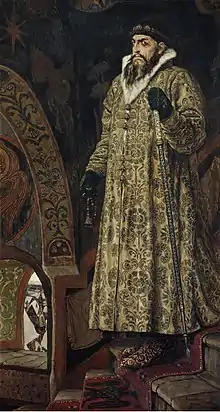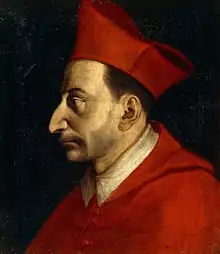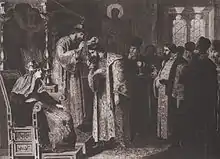1584
1584 (MDLXXXIV) was a leap year starting on Sunday of the Gregorian calendar and a leap year starting on Wednesday of the Julian calendar, the 1584th year of the Common Era (CE) and Anno Domini (AD) designations, the 584th year of the 2nd millennium, the 84th year of the 16th century, and the 5th year of the 1580s decade. As of the start of 1584, the Gregorian calendar was 10 days ahead of the Julian calendar, which remained in localized use until 1923.
| Millennium: | 2nd millennium |
|---|---|
| Centuries: | |
| Decades: | |
| Years: |
| 1584 by topic |
|---|
| Arts and science |
|
| Leaders |
|
| Birth and death categories |
| Births – Deaths |
| Establishments and disestablishments categories |
| Establishments – Disestablishments |
| Works category |
|
| Gregorian calendar | 1584 MDLXXXIV |
| Ab urbe condita | 2337 |
| Armenian calendar | 1033 ԹՎ ՌԼԳ |
| Assyrian calendar | 6334 |
| Balinese saka calendar | 1505–1506 |
| Bengali calendar | 991 |
| Berber calendar | 2534 |
| English Regnal year | 26 Eliz. 1 – 27 Eliz. 1 |
| Buddhist calendar | 2128 |
| Burmese calendar | 946 |
| Byzantine calendar | 7092–7093 |
| Chinese calendar | 癸未年 (Water Goat) 4280 or 4220 — to — 甲申年 (Wood Monkey) 4281 or 4221 |
| Coptic calendar | 1300–1301 |
| Discordian calendar | 2750 |
| Ethiopian calendar | 1576–1577 |
| Hebrew calendar | 5344–5345 |
| Hindu calendars | |
| - Vikram Samvat | 1640–1641 |
| - Shaka Samvat | 1505–1506 |
| - Kali Yuga | 4684–4685 |
| Holocene calendar | 11584 |
| Igbo calendar | 584–585 |
| Iranian calendar | 962–963 |
| Islamic calendar | 991–992 |
| Japanese calendar | Tenshō 12 (天正12年) |
| Javanese calendar | 1503–1504 |
| Julian calendar | Gregorian minus 10 days |
| Korean calendar | 3917 |
| Minguo calendar | 328 before ROC 民前328年 |
| Nanakshahi calendar | 116 |
| Thai solar calendar | 2126–2127 |
| Tibetan calendar | 阴水羊年 (female Water-Goat) 1710 or 1329 or 557 — to — 阳木猴年 (male Wood-Monkey) 1711 or 1330 or 558 |
Events

June 4: Roanoke Island is discovered.
January–June
- January–March – Archangelsk is founded as New Kholmogory in northern Russia, by Ivan the Terrible.
- January 11 – Sir Walter Mildmay is given a royal licence to found Emmanuel College, Cambridge in England.[1]
- March 18 (N.S. March 28) – Ivan the Terrible, ruler of Russia since 1533, dies; he is succeeded as Tsar by his son, Feodor.
- May 17 – The conflict between Toyotomi Hideyoshi and Tokugawa Ieyasu culminates in the Battle of Nagakute.
- June 1 – With the death of the Duc d'Anjou, the Huguenot Henry of Navarre becomes heir-presumptive to the throne of France.
- June 4 – Walter Raleigh sends Philip Amadas and Arthur Barlowe to explore the Outer Banks of Virginia (now North Carolina), with a view to establishing an English colony; they locate Roanoke Island.[2]
- June 11 – Walk (modern-day Valka and Valga, towns in Latvia and Estonia respectively), receives city rights from Polish king Stefan Bathory.
July–December
- July – The Siege of Antwerp (1584-1585) by the Spanish begins.[3]
- July 5 – The Maronite College is established in Rome, Papal States.
- July 10 – William I of Orange is assassinated in Delft.
- September 17 – Ghent falls into the hands of Alexander Farnese, governor of the Spanish Netherlands.[4]
- December – The Treaty of Joinville is signed secretly between the French Catholic League and Spain.
Date unknown
- Ratu Hijau becomes queen regnant of the once Malay Pattani Kingdom.
- Belgian cartographer and geographer Abraham Ortelius features Ming dynasty-era Chinese carriages with masts and sails, in his atlas Theatrum Orbis Terrarum; concurrent and later Western writers also take note of this peculiar Chinese invention.
- This year, according to Italian heretic Jacopo Brocardo, is regarded as an apocalyptic inauguration of a major new cycle.
Births

Archduchess Maria of Austria

Margaret of Austria, Queen of Spain
- January 1 – Charles de Lorme, French physician (d. 1678)
- January 7 – Karan Singh II, Maharana of Mewar (d. 1628)
- January 29 – Frederick Henry, Prince of Orange (d. 1647)
- February 9 – Francesco Maria Richini, Italian architect (d. 1658)
- February 12 – Caspar Barlaeus, Dutch polymath (d. 1648)
- February 18 – Philippe de Carteret II, son of Philippe de Carteret I (1552– (d. 1643)
- February 19 – Angelo Nardi, Italian painter (d. 1664)
- February 26 – Albert VI of Bavaria (d. 1666)
- March 15 – Philip, Duke of Schleswig-Holstein-Sonderburg-Glücksburg (d. 1663)
- March 22 – Grégoire de Saint-Vincent, Flemish Jesuit and mathematician (d. 1667)
- March 26 – John II, Count Palatine of Zweibrücken (d. 1635)
- March 29 – Ferdinando Fairfax, 2nd Lord Fairfax of Cameron, English parliamentary general (d. 1648)
- April 6 – Bridget de Vere, Countess of Berkshire, English countess (d. 1630)
- April 10 – Sibylle Elisabeth of Württemberg, Duchess consort of Saxony (d. 1606)
- April 20 – Sir John Langham, 1st Baronet, English Member of Parliament (d. 1671)
- April 23 – Jorge de Cárdenas y Manrique de Lara, Spanish noble (d. 1644)
- April 29 – Melchior Teschner, German cantor, composer and theologian (d. 1635)
- May 17 – John Jacob Hess, Swiss minister (d. 1639)
- May 23 – Maximilian von und zu Trauttmansdorff, Austrian diplomat (d. 1650)
- May 27 – Michael Altenburg, German composer (d. 1640)
- June 6 – Yuan Chonghuan, Chinese politician, military general and writer (d. 1630)
- June 15 – Anna Sophie of Anhalt, German noblewoman (d. 1652)
- June 16 – Archduchess Maria of Austria (d. 1649)
- June 25 – Richard Strode, English politician (d. 1669)
- June 26 – Robert Cholmondeley, 1st Earl of Leinster, English politician (d. 1659)
- July 17 – Agnes of Brandenburg, Duchess of Pomerania, later Duchess of Saxe-Lauenburg (d. 1629)
- July 26 – Gaspard III de Coligny, Marshal of France (d. 1646)
- August 1 – Emanuel Scrope, 1st Earl of Sunderland, English earl (d. 1630)
- August 10 – John Casimir, Count of Erbach-Breuberg (1606–1627) (d. 1627)
- August 11 – Philip Ernest, Count of Hohenlohe-Langenburg (1610–1628) (d. 1628)
- August 13 – Theophilus Howard, 2nd Earl of Suffolk, English politician (d. 1640)
- August 28 – Richard Treat, American city founder (d. 1669)
- August 29 – Patrick Young, Scottish librarian (d. 1652)
- September 11 – Thomas van Erpe, Dutch Orientialist, cartographer (d. 1624)
- September 13 – Francis Julius of Saxe-Lauenburg, Prince (d. 1634)
- September 15 – Georg Rudolf Weckherlin, German poet (d. 1653)
- September 16 – Giulio Roma, Italian Catholic cardinal (d. 1652)
- September 17 – John Finch, 1st Baron Finch, English judge (d. 1660)
- October 10 – Philip Herbert, 4th Earl of Pembroke (d. 1650)[5]
- November 3 – Jean-Pierre Camus, French Catholic bishop (d. 1652)
- November 10 – Catherine of Sweden, Countess Palatine of Kleeburg (d. 1638)
- November 16 – Barbara Sophie of Brandenburg, duchess consort and later regent of Württemberg (d. 1636)
- November 18 – Gaspar de Crayer, Flemish painter (d. 1669)
- December 15 – Queen Inmok, Korean royal consort (d. 1632)
- December 16 – John Selden, English jurist (d. 1654)
- December 25 – Margaret of Austria, Queen of Spain (d. 1611)
- December 27 – Philipp Julius, Duke of Pomerania (d. 1625)
- December 28 – Juan de Dicastillo, Spanish theologian (d. 1653)
- date unknown
- William Baffin, English explorer (d. 1622)
- Francis Beaumont, English dramatist (d. 1616)
- Antonio Cifra, Italian composer (d. 1629)
- Miyamoto Musashi, Japanese samurai, artist, philosopher (d. 1645)
- John Hales, English theologian (d. 1656)
- Hu Zhengyan, Chinese artist, printmaker, calligrapher and publisher (d. 1674)
- Robert Pierrepont, 1st Earl of Kingston-upon-Hull (d. 1643)
- Mathieu Molé, French statesman (d. 1656)
- Herman Wrangel, Swedish soldier and politician (d. 1643)
- Chiara Varotari, Italian Baroque painter (d. 1663)
Deaths

Bernal Díaz del Castillo

Tsar Ivan IV of Russia

Saint Charles Borromeo
- January 4 – Tobias Stimmer, Swiss painter and drawer (b. 1539)
- January 11 – Bernal Díaz del Castillo, Spanish constiquador (b. 1496)
- January 15 – Martha Leijonhufvud, politically active Swedish noble (b. 1520)
- February 18 – Antonio Francesco Grazzini, Italian writer (b. 1503)
- February 19 – Anna de' Medici, Tuscan princess (b. 1569)
- March 10 – Thomas Norton, English politician and writer (b. 1532)
- March 18 – Tsar Ivan IV of Russia (b. 1530)
- May 10 – Luigi Cornaro, Italian Catholic cardinal (b. 1517)
- March 12 – Kasper Franck, German theologian (b. 1543)
- April 13 – Jan Borukowski, royal secretary of Poland (b. 1524)[6]
- May 18 – Ikeda Tsuneoki, Japanese daimyō and military commander (in battle) (b. 1536)
- May 25 – Prospero Spani, Italian sculptor (b. 1516)
- June 10 – François, Duke of Anjou (b. 1555)[7]
- June 13 – János Zsámboky, Hungarian scholar (b. 1531)
- July 10
- Francis Throckmorton, conspirator against Queen Elizabeth I of England (executed; b. 1554)[8]
- William the Silent, Prince of Orange (assassinated) (b. 1533)[9]
- July 12 – Steven Borough, English explorer (b. 1525)
- July 14 – Balthasar Gérard, French assassin of William I of Orange (executed; b. 1557)[10]
- July 23 – John Day, English Protestant printer (b. 1522)
- August 22 – Jan Kochanowski, Polish writer (b. 1530)
- October – Colin Campbell, 6th Earl of Argyll, Scottish nobleman and politician (b. 1541)
- October 17 – St Richard Gwyn, Catholic martyr[11]
- November 3 – Charles Borromeo, Italian Roman Catholic cardinal and saint (b. 1538)
- November 17 – Eric II, Duke of Brunswick-Lüneburg (b. 1528)
- December 26 – Giovanni Francesco Commendone, Italian Catholic cardinal (b. 1523)
- date unknown
- Yi I of Joseon, Korean Confucian scholar (b. 1536)
- Elena Anguissola, Italian painter and nun (b. c. 1532)
- Mikołaj "the Red" Radziwiłł, Polish magnate (b. 1512)
- Carolus Sigonius, Italian humanist (b. 1524)
- Francisco de Toledo, Count of Oropesa, viceroy of Peru (b. 1515)
- Michal Wisniowiecki, prince at Wiśniowiec (b. 1529)
References
- Ford, L. L. (2004). "Mildmay, Sir Walter (1520/21–1589)". Oxford Dictionary of National Biography (Online ed.). Oxford University Press. doi:10.1093/ref:odnb/18696. Retrieved September 2, 2013. (Subscription or UK public library membership required.)
- Grun, Bernard (1991). The Timetables of History (3rd ed.). New York: Simon & Schuster. p. 259. ISBN 0-671-74919-6.
- "Battle of Antwerp | Summary". Encyclopedia Britannica. Retrieved November 21, 2017.
- Ripley, George; Dana, Charles A. (1873). "Ghent". The American Cyclopaedia. Vol. 7. New York: D. Appleton & Co. Retrieved December 4, 2011.
- Shropshire Archaeological and Natural History Society, Shrewsbury (1911). Transactions ... Adnitt and Naunton. p. 259.
- Tomasz Święcki (1858). Tomasza Święckiego Historyczne pamiątki znamienitych rodzin i osób dawnej Polski (in Polish). Nakładem S.H. Merzbacha. p. 283.
- Mark W. Konnert (2006). Local Politics in the French Wars of Religion: The Towns of Champagne, the Duc de Guise, and the Catholic League, 1560-95. Ashgate Publishing, Ltd. p. 161. ISBN 978-0-7546-5593-0.
- Leo Hicks; John Harland Hicks (1964). An Elizabethan Problem: Some Aspects of the Careers of Two Exile-adventurers. Fordham University Press. p. 31. ISBN 978-0-7837-0450-0.
- I.L. Leeb (July 31, 1973). The Ideological Origins of the Batavian Revolution: History and Politics in the Dutch Republic 1747–1800. Springer Science & Business Media. p. 19. ISBN 978-90-247-5157-0.
- Sir Roger Williams (1972). The Works of Sir Roger Williams. Clarendon Press. p. xxiv. ISBN 978-0-19-812428-3.
- Catholic Currents. Triumph Magazine, Incorporated. 1969. p. 4.
This article is issued from Wikipedia. The text is licensed under Creative Commons - Attribution - Sharealike. Additional terms may apply for the media files.
